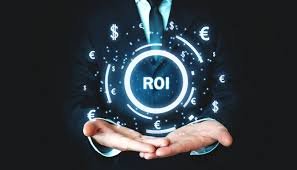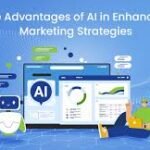Maximizing ROI with AI in Digital Advertising
In the fast-paced world of digital advertising, achieving a high return on investment (ROI) is the ultimate goal for marketers. However, as competition increases and customer behavior becomes more unpredictable, traditional advertising methods may no longer be enough. To stay ahead, businesses are increasingly turning to Artificial Intelligence (AI) to enhance their advertising strategies and optimize their ROI.
AI technologies, from machine learning to predictive analytics, have the power to revolutionize digital advertising by automating decision-making, targeting audiences more effectively, and continuously optimizing campaigns. In this article, we will explore how AI is transforming digital advertising and the best strategies for maximizing ROI with AI-driven solutions.
What is AI in Digital Advertising?
AI in digital advertising refers to the use of advanced technologies like machine learning, natural language processing (NLP), and deep learning to automate and optimize various aspects of advertising campaigns. AI systems can analyze vast amounts of data, predict consumer behavior, personalize content, and make real-time adjustments to advertising strategies.
By utilizing AI, businesses can deliver more relevant ads, optimize their ad spend, and improve overall campaign performance—leading to higher ROI.
How AI Maximizes ROI in Digital Advertising
1. Improved Audience Targeting
What’s Changing:
One of the most impactful ways AI is revolutionizing digital advertising is through enhanced audience targeting. AI uses data such as browsing history, social media behavior, demographics, and even real-time location to segment audiences more effectively.
Why It Matters:
Traditional methods of audience targeting often rely on broad categories and assumptions. AI, on the other hand, enables hyper-targeted advertising by analyzing individual preferences, behaviors, and interests. This allows advertisers to show the right ad to the right person at the right time, increasing the likelihood of conversion.
For example, an AI system can predict which users are most likely to engage with a specific ad based on their online behavior, thereby improving the overall effectiveness of the campaign.
2. Real-Time Campaign Optimization
What’s Changing:
AI-powered tools can optimize digital advertising campaigns in real time. These tools use machine learning algorithms to analyze campaign performance and automatically adjust bidding strategies, ad creatives, and targeting parameters to achieve the best possible results.
Why It Matters:
Manual optimization can be slow and often leads to missed opportunities. AI systems, however, can monitor performance and make adjustments instantly, ensuring that campaigns remain effective and efficient throughout their lifecycle. This leads to more efficient spending and maximized ROI.
For instance, AI can detect patterns in user behavior and automatically reallocate ad budgets to high-performing channels or ads, ensuring that the campaign budget is always spent in the most effective way.
3. Predictive Analytics and Forecasting
What’s Changing:
AI can analyze historical data and predict future outcomes with incredible accuracy. In digital advertising, predictive analytics help marketers anticipate customer behavior, trends, and the performance of different ads.
Why It Matters:
By leveraging predictive analytics, businesses can forecast the success of an ad campaign before it is launched, enabling them to allocate resources more effectively. Marketers can also adjust strategies early if predictions show underperformance, preventing wasted ad spend and maximizing ROI.
For example, AI tools can predict which keywords are likely to perform best for a PPC (pay-per-click) campaign, allowing businesses to bid more strategically and increase their chances of securing high-conversion clicks.
4. Dynamic Ad Creation and Personalization
What’s Changing:
AI enables the automatic creation of personalized ads by analyzing customer data and generating content that resonates with individual users. This process, known as dynamic creative optimization (DCO), allows advertisers to customize their ads in real time based on a user’s profile and behavior.
Why It Matters:
Personalized ads are far more likely to capture attention and drive conversions than generic ones. AI allows advertisers to create a variety of ad variations that are automatically tailored to specific segments of their audience, ensuring that each viewer sees the most relevant content.
For example, an online retailer can use AI to show different products to different users based on their previous browsing history or purchase behavior, increasing the chances of a sale.
5. Enhanced Ad Performance Analytics
What’s Changing:
AI-powered analytics tools are capable of providing deeper insights into ad performance by analyzing large datasets in real time. These tools can identify which aspects of a campaign are working, which are underperforming, and why.
Why It Matters:
With AI, advertisers can move beyond surface-level metrics like click-through rates (CTR) or impressions. AI allows for a deeper understanding of customer intent, engagement, and behavior, providing insights that can be used to fine-tune campaigns and maximize ROI.
For example, AI can help identify the optimal time of day to run ads, the best-performing ad copy, or which audience segments are most likely to convert, enabling more effective decision-making.
6. Programmatic Advertising and Automated Bidding
What’s Changing:
AI is at the heart of programmatic advertising, where ads are bought and placed automatically through algorithms. In programmatic advertising, AI helps automate the entire process, from bidding on ad space to targeting the right audience and optimizing ad delivery.
Why It Matters:
Programmatic advertising uses AI to make real-time decisions based on factors such as user behavior, context, and ad performance. This allows businesses to purchase ad space at optimal prices and deliver ads to the most relevant audience, improving ROI and efficiency.
For example, AI algorithms can determine the best price to bid for an ad spot based on current market demand and the likelihood of conversion, ensuring that businesses are getting the most value for their money.
7. Chatbots and Conversational Marketing
What’s Changing:
AI-driven chatbots are playing an increasingly important role in digital advertising by facilitating real-time, personalized interactions with customers. These bots can be used in various digital channels, including websites, social media, and messaging apps, to engage customers, answer questions, and guide them through the purchasing process.
Why It Matters:
Chatbots help bridge the gap between advertising and direct customer interaction, offering a seamless experience. They can assist in converting ad clicks into actual sales by answering questions, making recommendations, and guiding users through a purchase. This results in higher conversion rates and a stronger ROI from digital ads.
For example, a chatbot integrated into an ad can engage with users directly, helping them find the product they’re looking for and even offering personalized discounts, which leads to higher sales.
8. AI-Driven Social Media Advertising
What’s Changing:
Social media platforms are increasingly integrating AI tools to help advertisers improve their campaigns. AI can optimize targeting, content, and even budget allocation across platforms like Facebook, Instagram, LinkedIn, and TikTok.
Why It Matters:
AI-powered social media advertising tools allow for more precise targeting and greater personalization. AI can analyze user behavior across multiple platforms and deliver highly relevant ads that increase engagement and conversions. This leads to a more efficient use of the advertising budget and ultimately higher ROI.
For example, AI tools on Facebook Ads can automatically optimize your campaigns by analyzing user data and adjusting bids, targeting, and creative to maximize campaign performance.
Best Practices for Maximizing ROI with AI in Digital Advertising
- Start Small and Scale Up:
If you’re new to AI-driven advertising, start with one platform or campaign and test different AI tools. As you gather insights and see results, scale up your efforts and expand to other channels. - Leverage Predictive Analytics:
Use AI’s predictive analytics capabilities to forecast campaign success before launch. This can help you avoid costly mistakes and allocate resources where they will yield the highest return. - Monitor and Optimize in Real-Time:
Continuously monitor campaign performance using AI-driven analytics tools. Adjust your strategies based on the real-time insights AI provides, ensuring you’re always optimizing for the best results. - Focus on Personalization:
Use AI to personalize your ads, making them more relevant to your target audience. Personalized ads are more likely to engage users and convert them into customers. - Invest in Programmatic Advertising:
Embrace AI-powered programmatic advertising to automate ad placements, optimize bids, and ensure your ads are delivered to the right audience at the right price.
Conclusion
AI is no longer just a futuristic technology—it’s already transforming the landscape of digital advertising. By harnessing the power of AI, businesses can improve audience targeting, optimize campaign performance, predict future outcomes, and deliver more personalized, engaging ads. All of this leads to a significant increase in ROI.
For marketers looking to stay ahead of the curve, leveraging AI in digital advertising is no longer optional; it’s essential. By implementing AI-powered solutions, businesses can ensure they get the most out of their advertising budgets, improve customer experiences, and ultimately drive better results.
This article focuses on the practical application of AI in digital advertising, providing actionable insights for businesses looking to improve their advertising performance and maximize ROI. The blend of real-world examples and strategies for leveraging AI will likely resonate well with a broad audience of digital marketers, potentially leading to high CPC.


